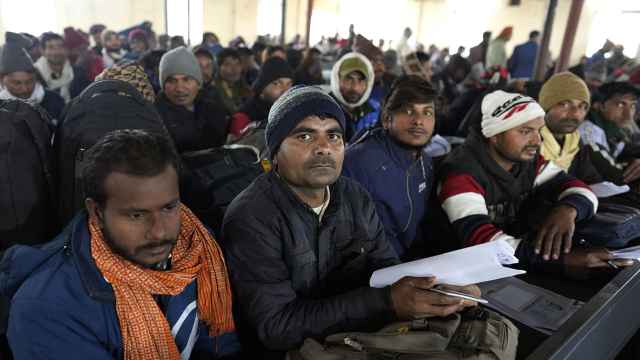In my recent post, "Russia's Crash and Recovery in Motion" I included a remarkable moving chart that dramatically shows Russia's collapse in the 1990s and the speed of its recovery in the following decade.
Several people have written in response and raised some important questions, namely: (a) Isn't this growth all about oil? and (b) Isn't catch up "easy growth"? The first implies that growth will stop as soon as the price of oil drops, and the second implies that growth will stop soon anyway as all the spare industrial capacity is used up.Before addressing them, I made a new chart that compares Russia not with the other BRICS countries (I left China in for reference), but a selection of other countries in emerging Europe.
It's a bit confusing and you have to play it a few times to see what is going on, but some interesting points come out.
To remind you how the chart works: a vertical fall represents a sharp decrease in income and horizontal movement to the right represents increases in household spending.
These are difficult questions because I don't see a way of separating out the variables, but this chart throws some light on just how big these variables are, in an intuitive way, anyway.
Clearly there are three things that go into the fuel that drives the growth this chart shows: "the oil effect" (having lots of petrodollars leads to spending that results in GDP growth); "the catch up effect" (simply putting bums on empty seats in Soviet-era factories leads to very cheap and fast growth); and "the reform effect" (making real improvements to the system results in long-term sustainable growth).
Turkey first. As this country never belonged to the Warsaw pact but was a basket case until the beneficial effects of globalization kicked in around 1990, we can use it as a proxy for the reform effect. And the chart shows clearly that both income and spending started growing at a very steady rate from 1990 onward.
Also take a look at Georgia. This is the most progressive reformer of all the CIS countries (an organization it left after the 2008 Russia-Georgia War), but like Turkey and Poland it has no natural resources at all. The point to note here is that after the collapse in the 1990s it grew more or less at the same pace as Turkey in terms of income and spending.
Poland next. Poland doesn't have any of the mineral resources many of the other countries of the former Soviet Union enjoy and is also clearly the most successful of the former Warsaw pact countries. It was one of the few countries in the world to avoid recession following the meltdown in 2008, and we can take it as a proxy for the reform effect plus the catch-up effect.
What is interesting about this one is that it has been growing steadily since 1991, while almost all its peers in the CIS spent that decade collapsing. The second point to note is that it grew much faster than Turkey throughout the last two decades. One assumes that its proximity to the West and then accession to the EU in 2003 both help it grow, but 2003 doesn't seem to make much difference to the rate of growth in the years immediately afterward. Also we have to assume that the early growth after 1991 was catch-up growth, but as the spare capacity was used up it switched smoothly into reform growth as businesses that had made big profits using up their cheap spare capacity reinvested this money into new facilities and kept making profits.
Now looking at the main CIS countries: Belarus, Ukraine and Kazakhstan. The main point to note with these is not only did income levels during the 1990s tank, but spending also went backward very fast in contrast to Russia, where spending levels remain fairly steady.
Kazakhstan clearly accelerates on the back of rising oil prices in the naughties, growing much faster than Turkey or Poland, but the surprise is Belarus, which keeps pace with it and even grows faster than Kazakhstan in the latter part of the last decade.
What I suspect is happening here is that Kazakhstan is growing thanks to the oil effect, whereas the strength of the catch-up effect in Belarus was equally powerful. Indeed, I chaired the first-ever Belarus international investment conference in London in November 2008, and the deputy prime minister told me that they had only just used up all their Soviet-era spare capacity and wanted foreign investment if they were going to continue growing. The fact that Russia was subsidizing their economy until 2008 in the form of cheap oil and gas prices also meant that the state could boost growth with massive spending. The combination of the end of the subsidizes, lack of growth-producing spare capacity and the international financial crisis have all combined to bring Belarus to its knees now.
And there is poor old Ukraine. Ukraine exports metal which, like Russia, makes up about 60 percent of exports. And like oil, metal has seen prices surge over the last decade thanks to rising demand in China et al. However, this windfall doesn't seem to have had much of an impact on the incomes and spending of the people. Indeed, according to this graph, Ukrainians suffered the most from the collapse of the Soviet Union with both their incomes and spending collapsing. Also, they seem to have benefited the least in the next decade. In short, we can say that the country has made some progress thanks to the "oil effect" but has little or no benefit from the catch-up or reform effects.
Finally to Russia. Comparing the trajectory of Russia and Kazakhstan and the oil effect is clear to see: Both of them move at about the same pace after their economies take off in 2000. But Russia starts to streak away from Kazakhstan from about 2005 — the start of its boom years. One explanation is that oil drove growth between 2000 and 2005, but after that the other two forces came into play.
Poland shows that if you can get two (or more) of these three factors to work together then you get a multiplier effect that allows your country to outperform all the others.
What of the catch-up effect in Russia? I looked at the question of capacity utilization in about 2005 in an article and found that most of the spare capacity had been used up by then so the catch-up effect, in terms of empty factory seats, had been largely exhausted, while investment was taking over. However, there is still more catch-up growth to be had as things that didn't exist in the Soviet-era are created, like supermarkets, and Russia is still enjoying a lot of catch-up growth.
But how does this compare to the reform growth? This is very hard to say. The conventional wisdom is that there has been no reform in Russia. But this is clearly not true. In a note I wrote with Plamen Monovsky, CIO of Renaissance Asset Managers, we found that the earnings of the representative companies in each sector where the state had implemented a reform massively outperformed the rest of the market. And this was true irrespective of what sector you looked at: banks, cars, retail, power and so on. However, the aggregate growth also shows that the reform effort has yet to have a universal beneficial impact on the economy as a whole, which is still growing in GDP terms by several percentage points below its potential.
What Russia's trajectory in this chart suggests is that from about 2006 onwards, all three factors — oil, catch up and reform — had begun to work in concert (what proportion of each is still unclear) and that it was producing exceptional growth so that Russia was about to overtake even Poland, the star of Europe's transformation.
Looking down the road post-crisis, it is becoming increasingly clear that Russia is at a crucial juncture now. I have seen an increasing number of papers from the investment banks worrying about growth going forward, saying the state-led model favored by the Kremlin is going to lead to stagnation.
Certainly the Kremlin is saying all the right things and clearly believes in the need for real reform. Evidence: the privatization program and President Dmitry Medvedev's anti-corruption drive. But implementation is the key, as it always is in Russia.
Still, what this chart suggests is that the reforms, incomplete and flawed as they are, are producing a beneficial effect. Coupled with the providential gifts of catch up and oil growth, it puts Russia in a strong position to continue its strong performance.
A Message from The Moscow Times:
Dear readers,
We are facing unprecedented challenges. Russia's Prosecutor General's Office has designated The Moscow Times as an "undesirable" organization, criminalizing our work and putting our staff at risk of prosecution. This follows our earlier unjust labeling as a "foreign agent."
These actions are direct attempts to silence independent journalism in Russia. The authorities claim our work "discredits the decisions of the Russian leadership." We see things differently: we strive to provide accurate, unbiased reporting on Russia.
We, the journalists of The Moscow Times, refuse to be silenced. But to continue our work, we need your help.
Your support, no matter how small, makes a world of difference. If you can, please support us monthly starting from just $2. It's quick to set up, and every contribution makes a significant impact.
By supporting The Moscow Times, you're defending open, independent journalism in the face of repression. Thank you for standing with us.
Remind me later.





